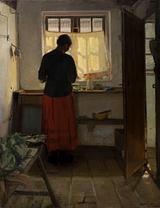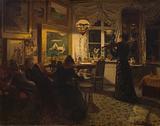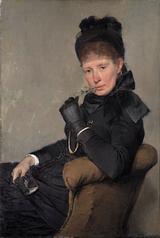Women artists
A selection of the most important Danish women artists of the 19th century

Anna Ancher’s 'The Maid in the Kitchen' from 1883–86 is one of the main highlights of the collection. Anna Ancher’s masterful use of light and keenly honed ability to conjure up a sense of intimacy is clearly evident in this atmospheric oil painting.
The Hirschsprung Collection owns works of art by some of the most important women artists working on the Danish art scene in the last half of the nineteenth century. Specifically, the collection houses a wide range of paintings, pastels, studies, sketchbooks and drawings by thirteen leading artists: Anna Ancher, Bertha Wegmann, Elisabeth Jerichau-Baumann, Anna Sophie Petersen, Anna Syberg, Agnes Slott-Møller, Marie Krøyer, Edma Frølich Stage, Emilie Mundt, Hermania Neergaard, Sofie Holten, Augusta Dohlmann and Marie Luplau.

In this 1891 painting we visit the living room of the artist Anna Sophie Petersen. Fellow artists Bertha Wegmann, Jeanna Bauck and Marie Krøyer are gathered in the lamplight, listening to the violinist Frida Schytte play.
Women on the 19th-century art scene
Up until the late 1800s, women were not allowed to enrol at the Royal Danish Academy of Fine Arts, and in the 1870s and 1880s a group of women artists, known as the ‘pioneer generation’, fought to obtain a fine-art education on a par with their male colleagues. The year 1876 saw the opening of the private art school Tegne- og Kunstindustriskolen for Kvinder (School of Drawing and Decorative Art for Women), and in 1888 the Academy opened a special line for women artists. Not until 1908 did the academy merge its Kunstskole for Kvinder (Art School for Women) with the long-established Royal Danish Academy of Fine Arts. After this point, men and women were taught together.
Even though women had few opportunities for getting an art education in their native Denmark, several of them went on to have successful careers as artists. One of them is the painter Bertha Wegmann, who was one of the leading portrait painters in Denmark in the 1880s. After having studied art in Munich from 1867 to 1881 and a long sojourn in Paris, where she exhibited her work at the prestigious Paris Salon, she returned to her native Copenhagen. Here she was much in demand, particularly as a portrait painter, and in 1883 she was the first woman to be appointed a seat in The Royal Danish Academy of Fine Arts’ Plenary.
Even though women had few opportunities for getting an art education in their native Denmark, several of them went on to have successful careers as artists. One of them is the painter Bertha Wegmann, who was one of the leading portrait painters in Denmark in the 1880s. After having studied art in Munich from 1867 to 1881 and a long sojourn in Paris, where she exhibited her work at the prestigious Paris Salon, she returned to her native Copenhagen. Here she was much in demand, particularly as a portrait painter, and in 1883 she was the first woman to be appointed a seat in The Royal Danish Academy of Fine Arts’ Plenary.

One woman artist paints another. In this portrait from 1885, Bertha Wegmann has depicted the Swedish artist Jeanna Bauck, whom she met in Hamburg in the 1860s. Bauck would since become one of Wegmann’s favourite subjects.
The artists in The Hirschsprung Collection
The founder of the Hirschsprung Collection, the tobacco manufacturer and art collector Heinrich Hirschsprung, collected works by women artists even before donating his collection to the nation in 1902. He was particularly keen on the work of Bertha Wegmann and the Skagen painter Anna Ancher, and as a result these two artists are well represented in the collection today. Since then, the museum has sought to augment its collection of nineteenth-century women artists. As a result, we still regularly acquire works by the thirteen women artists represented in the collection and by other women artists from the period.

Spring blossoms burst forth from their containers in Anna Syberg’s 1898 watercolour. Syberg was part of the artists’ colony fynbomalerne (the Funen Painters) on Funen and played an active part in establishing the Faaborg Museum.